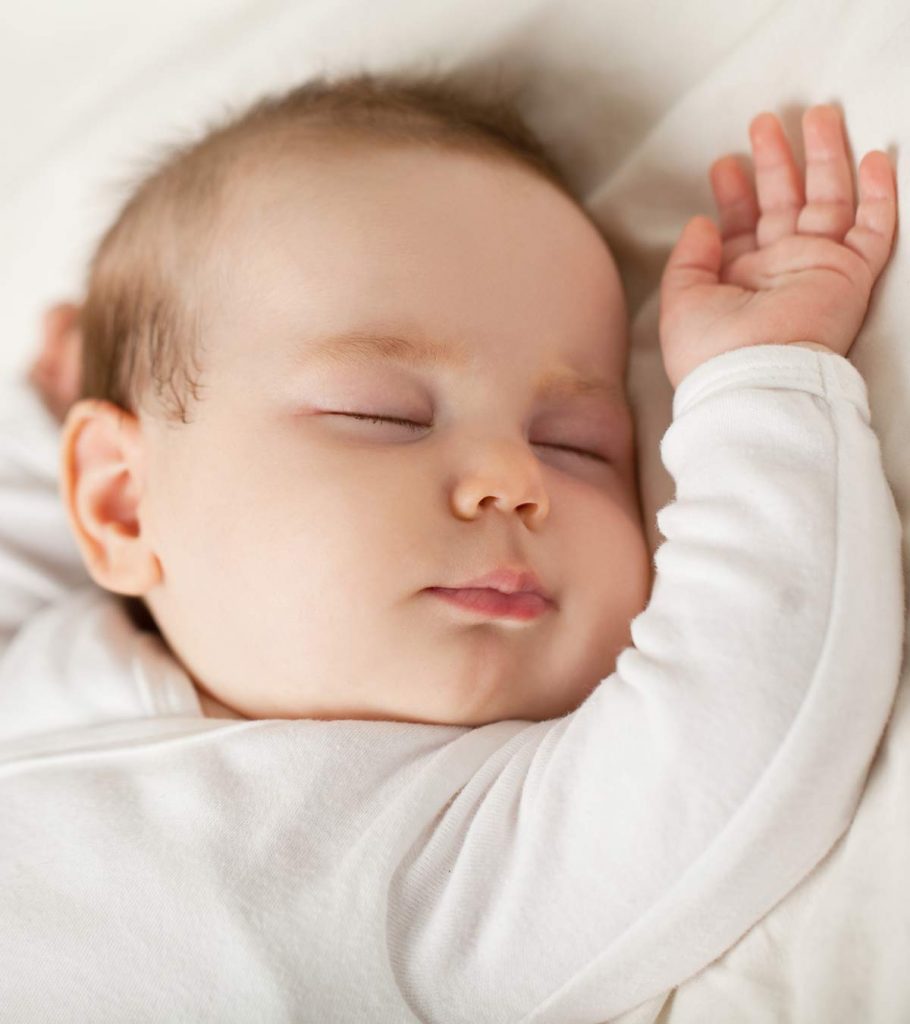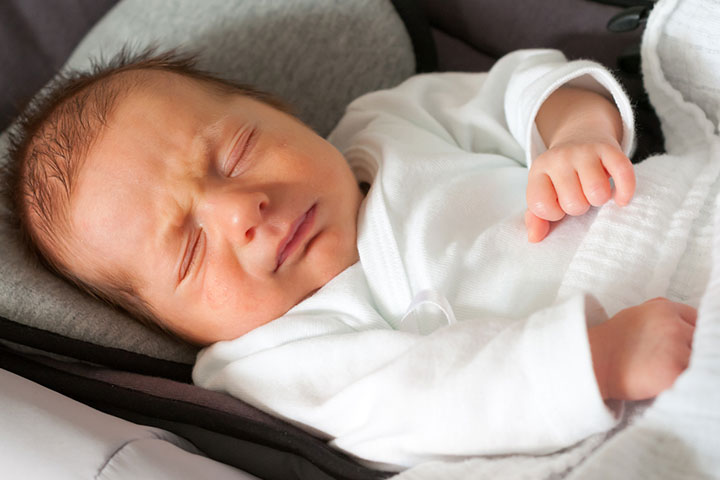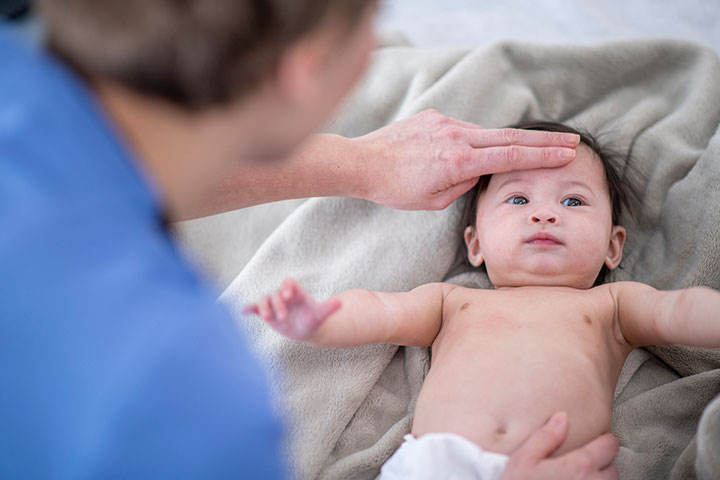Any new parent would love to witness all movements of their babies, including smiling, rolling over, communicating, and sleeping. However, as you watch your baby sleep peacefully, you may suddenly notice your baby twitching in sleep sometimes.
Sleep twitching is when your baby has little jerks and spasms during sleep. These spams could occur in the arms, legs, eyes, eyelids, fingers, toes, head, mouth, and cheeks (1). Twitching is a mild condition involving involuntary muscle movement and is usually seen during the early stages of sleep.
Sometimes referred to as ‘sleep starts’ or ‘sleep myoclonus,’ twitches affect most newborns and babies (2). The condition is referred to as benign neonatal sleep myoclonus in medical terms. Most parents and elders think that babies twitch in sleep in response to a dream, but what could be other reasons for it?
In this post, we tell you about how common twitching is in babies and when to be concerned about it.
Is It Normal For Babies To Twitch In Their Sleep?
A newborn twitching in sleep or sleep myoclonus is not considered a serious condition. Twitches in babies are most common from birth to three years of age (3). However, in most cases, it resolves on its own between two and six months of age (4). Moreover, it has been reported that this condition has no long or short-term effect on infants and is not associated with any neurodevelopmental abnormality (4).
When a baby or toddler is twitching, do not panic but take a video on your mobile phone (or ask someone else nearby to do it). The video will be helpful to your doctor in diagnosing the problem.
What Causes Twitching In Sleep?
The cause of the twitching is still not clear. Interestingly, researchers have observed that twitching can last as long as 10 to 20 seconds (4). Twitching during REM (rapid eye movement) sleep has been linked to sensorimotor development (5).
It is believed that when a baby twitches in sleep, the action activates the circuitry of the developing brain and teaches the babies about their limbs and what they can do with them. Moreover, researchers have uncovered how twitching can be related to the new developing skills of the baby.
For instance, they suggest there may be a link between the babies twitching and moving their neck during sleep and their ability to support their heads while they are awake, or they may twitch their fingers or toes when they are crawling and starting to reach for objects (1).
When Is Twitching In Sleep A Concern?
Twitching in sleep is usually harmless. However, the primary difference between night myoclonus and other conditions is that it occurs only in sleep. If you notice twitching or stiffening when your baby is awake or if you have developmental concerns, it may be a cause for concern and require a medical evaluation for the probable presence of the following conditions.
- Infantile spasm: It is a type of epilepsy and occurs between two to 12 months of age but becomes prominent when the baby is four to eight months old. The seizures usually last one or two seconds but occur in a series every five to ten seconds. During these infantile spasms, the baby’s body stiffens, while the arms, legs, and head may bend forward, and the back may arch (6).
Chris Seay, a dad, shares his daughter, Gaby’s experience with infantile spasms. He says, “Gabby woke up around 7:15 that morning, and I got up to feed her. I noticed something strange. Every few seconds, without skipping a beat with her bottle, Gabby would stretch her arms out to her side. It looked like someone getting a chill up their spine or the ‘startle’ reflex that babies sometimes have while they’re sleeping. She did it six or seven times that morning… Later that day, my wife Missi was feeding Gabby her bottle, and she noticed the same thing… Neither of us were too concerned. It appeared to just be a little twitch, so we dismissed it quickly.
“Gaby seemed to have a cold, and that is why the parents took her to the doctor the next morning. The doctor said the cold was nothing to worry about and asked if they had any other concerns. Seay and his wife mentioned the unusual arm movements, and the doctor asked a few questions, but because they could not explain it well, the doctor said he could not diagnose anything without seeing them. Later in the day, when Gaby showed those movements, Seay recorded them and got back to the doctor’s office to show those videos. The doctors mentioned it could be an infantile spasm and recommended getting an EEG done to confirm the diagnosis…
“We rushed downtown to the hospital. She (the doctor) ordered an EEG that night and an MRI. The staff told us that we would be seeing the neurologist, who went on to describe it as a ‘chaotic brain wave pattern.’ No doubt, at that point, Gabby had infantile spasms (ⅰ).’’ Her diagnosis was followed by the doctor explaining the treatment options, which included ACTH injections twice a day for thirty days. Gaby responded well to the injections, and by day five, she didn’t have any spasms at all.
- Benign familial neonatal convulsions: This condition is characterized by recurrent seizures that begin when the newborn is three days old and resolve by the time the baby is one to four months old. The seizures can involve either one or both sides of the brain and affect the entire body. The signs may include convulsions, trembling, muscle rigidity, and loss of consciousness (7).
- Febrile seizures: These seizures are usually caused by a spike in body temperature or fever along with an infection (cold, flu, or ear infection). Children between the ages of six months and five years may experience febrile seizures. In the majority of the cases, febrile seizures are a form of convulsions. The symptoms may include loss of consciousness, vigorous shaking of arms or legs, rolling of eyes, screaming, grunting, and rigid limbs (8).
- Seizures: Abnormal electrical and chemical changes in the brain can lead to seizures. Seizures may lead to a temporary change in consciousness, behavior, sensation, or physical movement. The National Institutes of Health estimates the incidence in the United States to be between 80 and 120 cases per 100,000 neonates annually. There are various types of seizures, and some signs may include loss of consciousness, convulsion, staring but only for a brief period, confusion, uncontrolled shaking of legs and hand, twitching, flexing, stiffening of the upper body, sudden panic or fear, crying, fussing, flinching and nodding (9).
- Epilepsy: It causes recurrent seizures for known or unknown reasons, depending on the case. Epilepsy often leads to repeated unprovoked seizures unrelated to an acute illness or medical condition, such as brain injury (9).
- Periodic limb movement disorder (PLMD): PLMD is a sleep disorder that causes lower limbs to jerk, cramp, or twitch repeatedly during sleep. During an episode, the leg movements may involve one or both limbs. These repetitive movements may occur about every 20 to 40 seconds. Although it is rare in babies and children, the presence of neuropsychiatric disorder, sleep apnea, or even having a parent with restless leg syndrome (RLS) increases the risk of developing PLMD (10).
A conclusive diagnosis of any of these neurological conditions requires multiple medical assessments and ruling out of various possibilities. Therefore, do not panic if your baby twitches often and speak to a pediatrician or a neurologist since early diagnosis of any problem could lead to a better prognosis.
It is important to differentiate benign neonatal sleep myoclonus from seizure disorders as the latter usually need anticonvulsants for management while sleep twitchings are not diminished by anticonvulsant drugs and only diminish with age.
Your baby twitching in their sleep is not a cause for concern as it is a part of their sensorimotor development. It is most common from infancy to up to three years of age. All signs of twitching are not related to epilepsy. However, consult your pediatrician if you notice signs of seizures, spasms, or convulsions while your baby is asleep. Take proper care of your little one and keep an eye out for concerning symptoms, such as twitching or stiffening when awake, which might signify complications.
Key Pointers
- Twitching in sleep is normal in babies, and it usually disappears within a few months.
- The exact cause of twitching during sleep is not clear. It can be due to sensorimotor development in babies.
- Some babies can have infantile spasms and seizures, and you may look for the signs and seek medical care if you are uncertain whether they have twitching or seizures.
Concerned about your baby’s movements while sleeping and wondering what you can do to help? Watch this informative video that provides advice on how to best handle such a situation.













